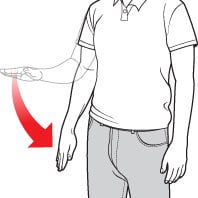Four Hand
Signals
For Dogs
SIT

Using minimal arm movement, point to the floor with your index finger.
DOWN

Start with the dog in a sitting position. With your palm facing down, move your arm toward the ground.
STAY

Hold out your hand in a “stop” gesture.
SPEAK

Hold your hand with all four fingers pointing toward the ceiling. Your thumb should be tucked under your chin. Move your hand away from your mouth and back again.
Illustrations by Pete Sucheski.
Trainer, behaviorist, positive reinforcement–the lexicon of dog training can be baffling. To complicate matters, there’s debate within the training profession about which methods are most effective. Add in the fact that there are no state or federal legal requirements or agreed-upon standards for what constitutes a dog trainer or behaviorist–anybody can claim to be qualified.
What should dog owners in need of professional help do? To start, there’s a growing body of literature on the topic to consult–see some recommendations on the next page. Before hiring a trainer or behaviorist, talk to their references and consult your pet’s veterinarian. But not unlike making parenting decisions, finding solutions to dog behavioral problems depends largely on personal preference.
Dahlia Awad’s life changed on a freezing day in December 2010. She had arrived home from work and let her two Siberian huskies into her yard, which backs up to Lake Barcroft near Falls Church. When she went to let them back in, something was wrong: “They were standing and staring at the water.”
Realizing that her huskies were watching a dog struggling to get out of the lake, Awad ran to the water and managed to pull the skinny, shivering rottweiler out. She brought her inside, where she made a bed in front of a heater. The next day, she took the female dog to the vet, who said the dog’s uterus was infected and had to be removed. Awad agreed to pay for the procedure. Though she and her husband hadn’t planned to add a third dog to the family, they were now invested financially and emotionally in an animal they knew nothing about. They named her Molly.
Molly spent the next few weeks medicated and resting. She seemed like a sweet dog and got along with the couple’s two huskies. But once her recovery was over, it was a different story. Molly barked and lunged at visitors and was aggressive toward other dogs. “When we started to get to know her,” says Awad, “we realized we weren’t equipped to deal with this animal.”
David Lesser and his wife, Nancy, hadn’t planned to get another dog, either, when they called the springer-spaniel rescue group where they volunteer and asked if any dogs needed a ride south. The Lessers, along with their own springer spaniel, were about to travel from their home in Bethesda to their Florida beach house. It turned out one of the group’s dogs, Henry, needed transportation to a foster home in Hilton Head, South Carolina.
“By North Carolina, we had fallen in love and decided we should foster him,” says David Lesser. By the end of their one-month stay in Florida, the couple had decided to keep Henry. However, they’d started to notice troubling behavior. For instance, if Henry was sitting by Nancy when David approached, the dog would growl.
Months passed and things got worse, particularly at night when Henry would steal and guard items such as shoes, socks, and books. “If you came anywhere near him, he would get this glazed look and growl ferociously,” says Lesser. “We didn’t know what to do.”
Awad and Lesser had both stumbled into owning dogs they weren’t prepared to manage. They loved the animals and were committed to helping them, but they ultimately relied on opposing methods to address Molly’s and Henry’s problems.
At a friend’s recommendation, Awad called Pam Nashman, who runs All About Dogs, a training business in Woodbridge. Nashman considers herself a trainer as opposed to a behaviorist.
Though neither term has a clear-cut definition, a trainer is generally someone who teaches dogs new skills and ways of communicating with people–for instance, that certain hand gestures and commands mean to sit or stay. A behaviorist is more focused on modifying behaviors and uncovering the psychology behind them–for example, whether a dog is acting out because he’s fearful.
Often, dogs with more serious emotion-based problems such as aggression or separation anxiety require a behaviorist, whereas dogs that simply need to learn manners can make do with a trainer.
However, the line between trainer and behaviorist can be blurry, because most trainers agree that to be effective they need to understand a dog’s motivations and emotions.
One profession that’s easily definable is a veterinary behaviorist. This is a vet who has undergone advanced training in animal behavior–essentially, a canine psychiatrist. Only two of these are in the Washington area, Dr. Kathy Meyer in Gaithersburg and Dr. Marsha Reich in Rockville. Veterinary behaviorists can also prescribe psychotropic drugs.
Though Pam Nashman says she primarily focuses on behavior modification, she calls herself a trainer to avoid confusing consumers. She and the ten other trainers who work at All About Dogs use only positive-reinforcement techniques.
According to this method, owners should focus on rewarding and reinforcing good behavior rather than on punishing dogs for misbehaving. Positive-reinforcement trainers don’t believe in using tools such as pinch, prong or electric shock collars, which are used to cause dogs pain or discomfort when they fail to follow commands.
Dahlia Awad says the choice to use positive reinforcement was a no-brainer: “Molly was a needy, special dog. Think of a kid that’s been neglected. To me, the only way you’re going to rehabilitate that kid is through love and trust and discipline. A dog is no different.”
To start, Nashman did six hourlong in-home sessions with Molly to help with her anxiety around visitors. Awad’s neighbors would come over to play the part of “friendly strangers.” When they came in, everyone would ignore Molly so she wouldn’t feel challenged and act aggressively.
Once Molly and the neighbors settled in, Nashman coached Awad to begin feeding the dog treats. The goal was to teach her to associate visitors with something positive–in this case, a tasty snack. For other dogs, positive reinforcement can range from belly rubs to playing with a favorite toy to hearing the sound of a dog clicker, a popular tool among trainers that creates a sound that appeals to dogs.
Awad says Nashman also taught her to read Molly’s posture and facial expressions and to keep the dog’s attention focused on her–all techniques to help Awad maintain control. During the sessions, Molly would eventually get curious about the visitors and walk over to greet them calmly.
The in-home training curbed Molly’s reaction to strange people but not to the dogs she often met on walks. That would require even more work.

















